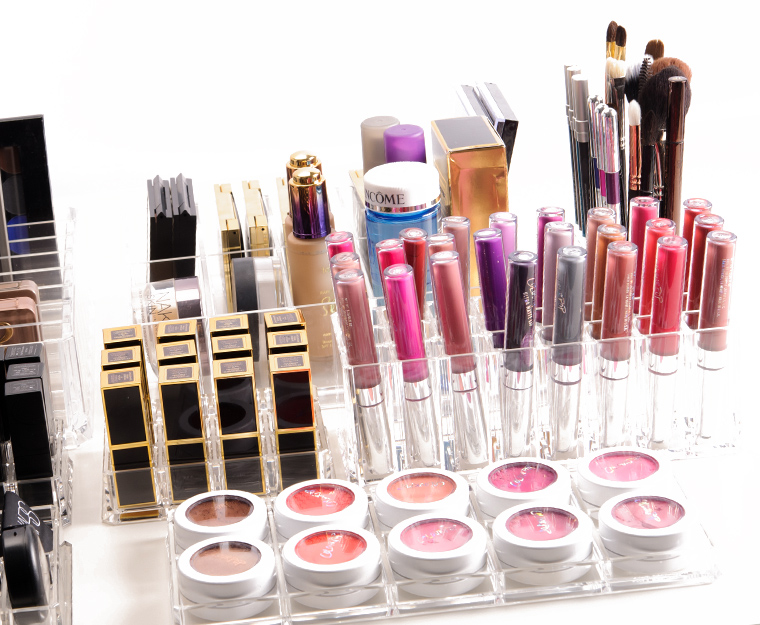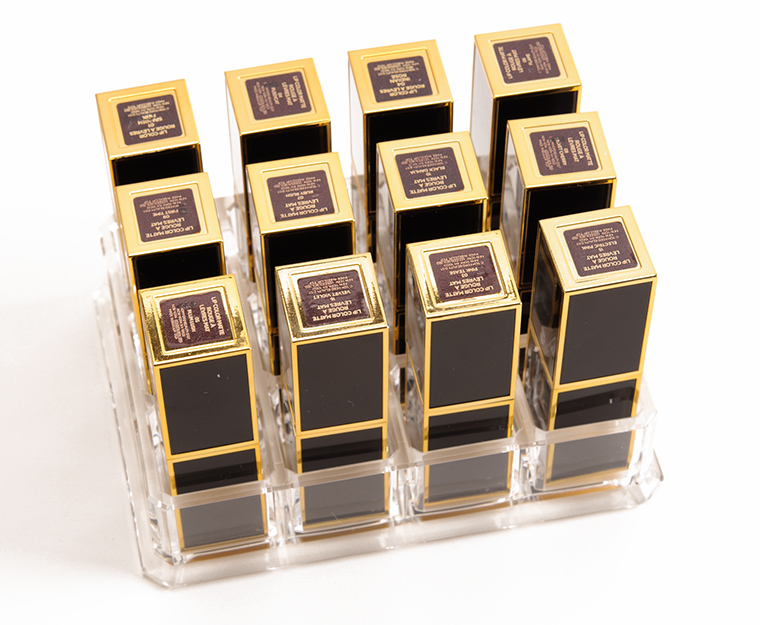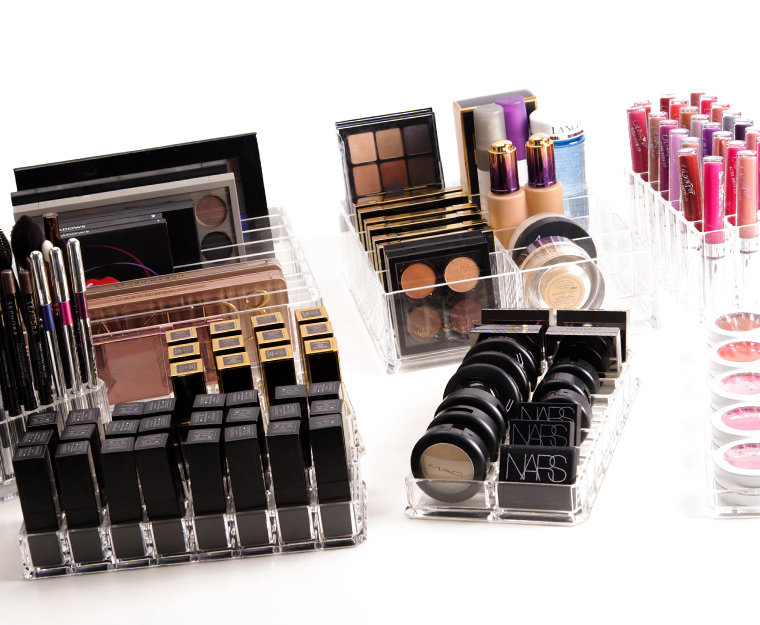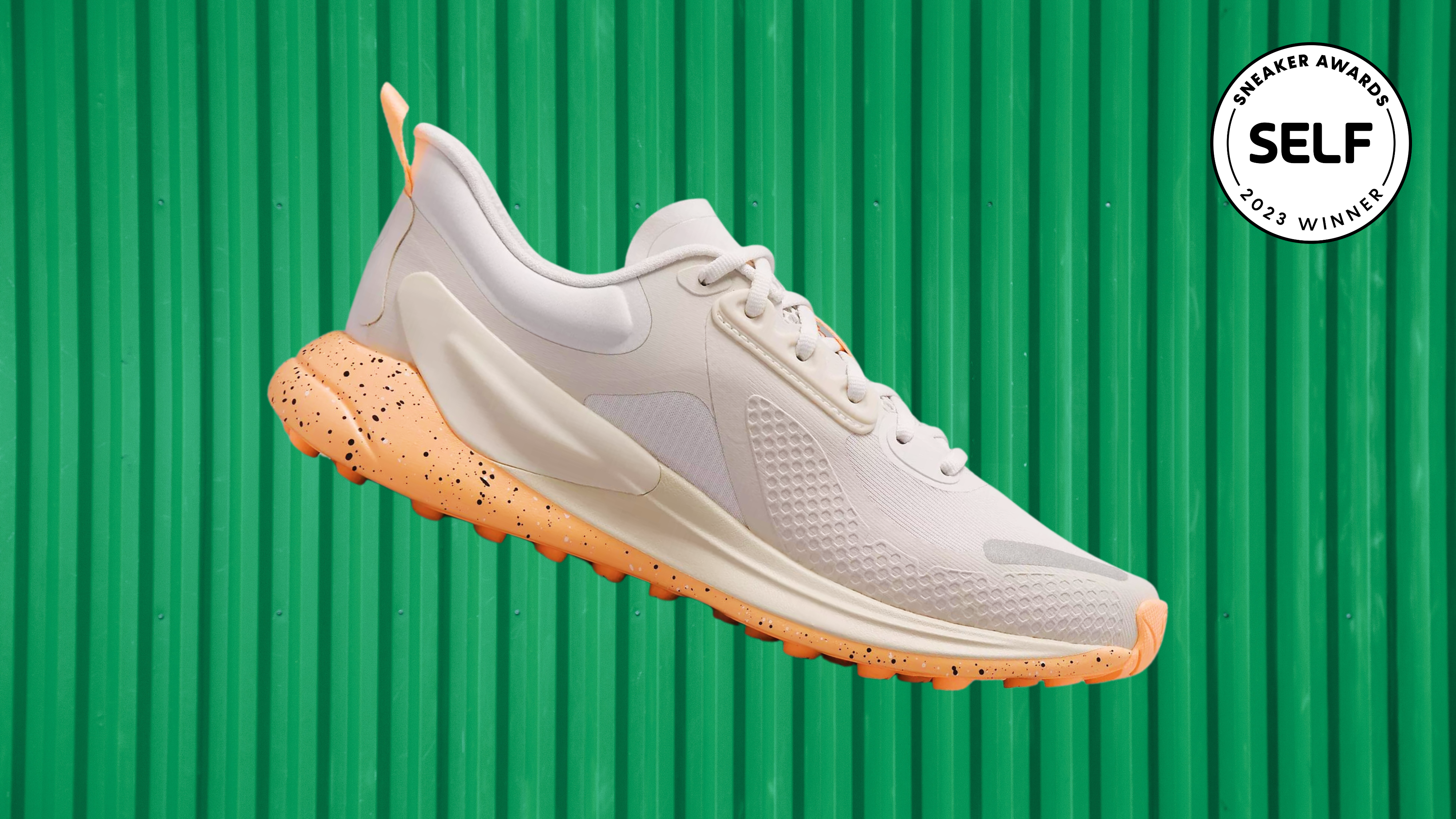
If you find yourself prone to purchasing on impulse or often feel like you purchase products that are well-reviewed, popular, or buzzed about but don’t actually find you love them like you feel you should, this list of tips might help you figure out how to better understand your own preferences and needs and purchasing behavior.
Step 1: Create a Makeup Inventory
Before you even think about purchasing another product, STOP! Let’s work through what you’ve purchased in the past, how that’s worked out (or not worked out), and what the takeaways might be from past purchases. By figuring out where you’ve gone right and where you’ve gone wrong, you’ll know what areas have room for improvement.
It’s a good idea to have a good recollection of what products you have as this will ensure that you’re using the products you have regularly. If you get to the point where it’s hard to remember it all, you might want to consider a more formal inventory process, like a spreadsheet, bullet journal, or use Temptalia’s Vanity. The upside to any digital version is that you can easily find or sort by various parameters (like finding out what eyeshadows you have or what MAC products you have).
If you’ve purchased products and returned or otherwise removed them from your stash and you can remember them, consider keeping an additional tab on a spreadsheet or use our Archive functionality in the Vanity (for products you have tried but no longer have). Knowing what didn’t work can be just as useful in building up self-knowledge as knowing what has worked well!
If you’ve destashed a dozen liquid lipsticks and kept one, maybe liquid lipsticks aren’t really your thing so you can mentally note to temper excitement in the future if you see a color that catches your eye but comes in a liquid lipstick formula.
If you’re setting up your own spreadsheet or journal, here are some characteristics you might want to include:
- Brand + Shade
- Type of Formula (e.g. Lipstick)
- If a type has enough variety in formulas, you may want to include additional information like loose vs. pressed or liquid vs. cream.
- Color
- Depending on how many products you have and how you think about color (or how you decide what to use), additional parameters like undertone and finish may be useful.
- Price
- You might put the price you paid if you want to keep track of spending or the retail price at the time you purchased.
- Photos/Swatches
- If you’re feeling particularly industrious, you could include your own photos/swatches of the products you own!

Step 2: How to Declutter Your Makeup Collection
It’s entirely possible that you’ve already done so or have managed to make fantastic purchases and have nothing you want to part with, and if that’s the case, congratulations, and you can skip ahead! For those who have felt like they’ve just accumulated a little too much or haven’t been as discerning as they’d like, now that you know what you have, it’s a good time to work through what you have with a more mindful eye.
Let me introduce you to: makeup decluttering or makeup destashing. What is decluttering? It’s removing products that you no longer use from your makeup collection — clutter. They’re products taking up space, that might create noise and make other products harder to find/see, and are no longer, rarely, or begrudgingly used.
I’ve touched on some of my recommendations and advice on fine-tuning the products you own previously when I wrote about how to organize your makeup collection, so you may find some of the tips below familiar.
If and when the amount of makeup you own starts to give you negative feelings or reactions, that’s when it’s time to reassess what you have, why, and whether it’s time to let it go. If you love everything you have, and there’s no outside reason to downsize, there’s nothing wrong with having more products. It’s not a competition of who has the most or who can get by with the least.
It’s about getting to a size that you find manageable, whatever that means for you; it doesn’t have to be manageable for someone else, just you.
First, these are the five questions I think are important to ask about products I’m trying to decide whether to keep or declutter…
- Does this product work well for how I want to use it?
- When was the last time I used this?
- Did I like it last time I used it?
- Do I have other products that are similar to it (whether in color or function) that I use more often and/or prefer to it?
- Do I see myself using it again?
What are the obvious things to declutter?
The easiest products to let go are the ones that are expired, whether you follow strict use-by dates (on most labels) or if you go by smell/texture/performance tests. If there are particular products that are sentimental to you (and that’s why you’ve been keeping them long past the expiration date!), go through your memories and evaluate if keeping the product adds to that memory or if you really hold the memory in yourself already.
Consider separating these types of products out and finding a way to display and honor them, if they are so sentimental, instead of keeping them in a box or drawer that you forget about.
The products that worked terribly for you should be the next easiest to say ta-ta to. These are the ones that you’ve tried, hated, and shoved in the back of the drawer and never reached for again. These are products that you feel look bad on you (wrong color, one star!), wore poorly, were difficult to work with, etc.
If there are products that did not work for you and you cannot let go, then set them aside and make a point to use them again, then reassess if it’s really adding usability and/or joy to what you have.
What else should you declutter?
Based on what I’ve seen readers and others in the community speak about, and what I’ve personally experienced as I’ve become more and more discerning about what I keep myself, these are the types of products that can make you waffle a little…
Expensive flops. The money’s spent. Keeping a product you don’t like and don’t use just takes up space and doesn’t pay you rent. You aren’t getting your money back by keeping it.
So-so products. If it’s so-so but you don’t use it, it’s likely because you don’t like it much on yourself, you rarely have reason to use it (e.g. maybe it’s the type of color you only like for special occasions, which leads me to my next point…), or have a better-performing product that is comparable in purpose (color, finish, function).
Unicorns. These are going to be products that you just have the one of, maybe for you it’s a super, glittery highlighter. The question is whether you use it, enjoy it, and does serve a purpose in your collection. There might be a reason why you only have one, and it might be because you don’t really enjoy that type of product but felt compelled to give a chance for a myriad of potential of reasons.
But limited edition. Use it or lose it. What good is that gorgeous limited edition that you love every time you wear it but only allow yourself to wear very occasionally for fear of running out of it? How many products you do you actually finish? What is the real likelihood that you’ll finish? Just how amazing and unique and utterly special is this one limited edition item that even if you used it regularly and finished it that you’d be destroyed because it was no more? There’s always something new and shiny right around the corner in beauty, and our tastes and preferences change over time – you might be sick of that shade after using it ’til the bitter end!
What if I have trouble decluttering?
There are some common excuses I’ve come across for why a product that seems like it doesn’t have a good purpose for someone is otherwise kept (and rarely or never used), which I’ve summarized and countered below. I do, however, want to make it clear that curating your makeup collection is about making you happier, not more miserable. If you find yourself struggling, that’s okay; everyone’s journey is different and certain parts may be harder for some than others. Maybe for you success is destashing one product–just make sure you’re putting in a conscious effort to make your collection work better for you.
For those where the mental block goes beyond just feeling like you wasted money but goes deeper and is more rooted in a fear of no longer being in the position of being able to afford products, consider decluttering as a way to remove the noise from what you have today but store the decluttered products in a safe place until you are able to move past that fear (to whatever degree you may be able to).
Decluttering is not about minimalism or capsule collections or aspiring to a specific aesthetic or size of a collection. Anyone who takes what they have and adopts a minimalist lifestyle by the acquisition of more things is doing so from a place of privilege. Adopting more mindful purchasing habits, being more aware of how and what we use in our collections, and having the willingness to accept that sometimes products don’t work for us or we shouldn’t have purchased something (so we can let go of it) are the goals.
“I already spent money on this, so I should have to use it because I wasted money on it!” If you have additional products that you could be using, there’s no reason to punish yourself for past mistakes. This is supposed to be a fun, creative outlet. You want to learn from mistakes you’ve made in the past to make better decisions in the future; that’s what you should be taking away from bad purchases.
“What if I need this product-I’ve-used-once-and-doesn’t-fit-my-preferences-at -all someday?” That excuse can work a few times, but it can’t be the excuse used for every single item you have and never use. Is this someday a real, feasible event? Maybe you don’t love neutrals but are about to graduate school and will be entering a career that often requires neutrals you can grab at this excuse, but if you think teal eyeshadow looks awful on you, want to remove it every time you wear it, then what is this someday you’re looking for? You want to realistic about potential changes, especially when it comes to personal preferences.
“I’ll regret it if I get rid of it!” Take everything you’re willing to part with but are afraid you’ll regret parting with and put it into a box. Take that box and put it somewhere you rarely see, like the back of a closet or under a bed. Leave it for at least a few weeks, and then think about whether you actually missed any of the products you put in it.
“The packaging is so pretty!” If you find the design/packaging/presentation attractive, then it’s not makeup, it’s art. You bought 3D art, and art is meant to be enjoyed, e.g. be on display, not tucked in a drawer or bin or wherever so you better find a place to display it!

Step 3: Questions to Ask Before You Purchase
When adjusting purchasing habits, one of the keys is to be more diligent about the process before the purchase. This is the time spent deliberating over the purchase, which may be subject to a number of questions, checklists, steps, and processes based on your individual needs and what works for you. Here are some actions I like to take when making purchasing decisions, both big and small, that can be applied to beauty purchases but also purchasing in general:
Is it within my budget for beauty (or “fun” money) for the time period?
Creating a budget is an excellent tool to see where your money goes each month, as this helps see if you’re over-spending in a particular area while providing a better idea of cash inflows and outflows. If you have the ability to do so, you can set a spending amount for a time period for a category, like $X per month allowed on makeup. If you find it harder to reduce spending, you may find stricter rules and specific limits to be more useful than more arbitrary ones.
How would this purchase impact my financial goals?
I always find having a financial goal in mind helps to curb excess and unnecessary spending because I have a bigger picture in mind. This might be something like taking a great vacation, paying off student loans, contributing to retirement, buying property, or any number of worthy goals.
I like having both short-term and long-term financial goals setup so that I have more immediate satisfaction of contributing to a short-term goal while also working towards a long-term goal. For example, I try to contribute as much as I can to pre-tax retirement each year for my long-term goal of being able to retire early (which is really the goal of working because I want to, not because I have to).
How will I use this product? Where does it fit into my collection?
If you’re adding a product to what you already own, then ideally, it should be adding something of value. It should serve a purpose and be a product you expect to use and enjoy. A lot of what I ask myself here are the same questions I ask about whether I should keep or destash a product: will I use it, how often will I use it, do I have anything similar to it (do I really think this is going to be better? why?), etc.
Have I done my research on it?
If you can find reviews, swatches, or even try it in person, you should be attempting to do so! You might have to set aside some time to be more proactive finding reviewers that you trust and align with, or to filter and skim through dozens of consumer reviews on various retailer websites. If it’s a brand new product, you’ll want to consider your history with the brand and their products, whether you’re comfortable purchasing blindly or if you’d really rather wait for some reviews.

Step 4: Track New Purchases Critically
If you thought the process stopped there, you’d be so wrong — that’s how products we don’t love and use accumulate! Once you’ve decided to purchase something, the next step is to try it and see how it works for you. This will allow you to see exactly how it will or will not work for your needs and within your collection of products.
If you’re fortunate enough to live in a region that allows returns or exchanges, returning a product that does not work for you, that was hopefully purchased mindfully (not everything works out!), in a timely manner is a good way to avoid accumulating products that do not work for you. The ability to try and return is a nice-to-have, but it isn’t an excuse to buy products willy-nilly because you can return (as in beauty, most returned products are destroyed/thrown away/disposed of, not resold), which results in unnecessary waste.
If you keep the product, make sure you have a place to put it, as an organized stash leads the way to a more well-loved and well-used collection of products. If you’re keeping track of what you own, add it to your inventory. And enjoy!



